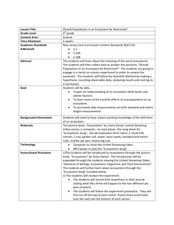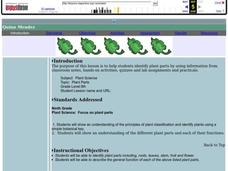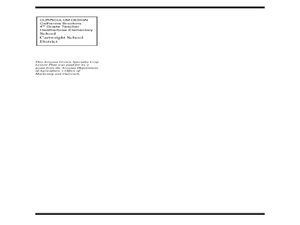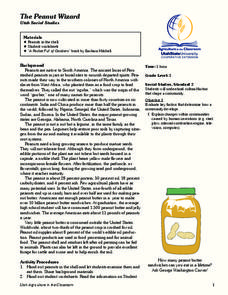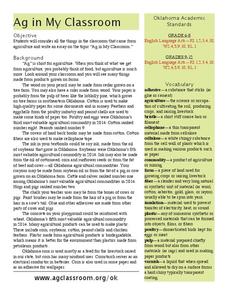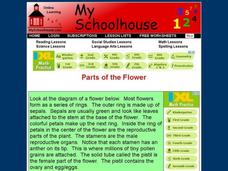Curated OER
Preparing the Soil
Learners explore the concept of philanthropy. In this service learning lesson, students read Seedfolks and discuss the characters in the story and consider their actions that led to a community garden. Learners journal about their...
Curated OER
Preparing the Soil
Students explore philanthropy through literature. In this service learning lesson, students consider character traits as they read Seedfolks. Students record their notes regarding the characters in the story of a community garden in...
Curated OER
Eating Plants
Students identify parts of a plant. In this life science instructional activity, student groups locate the leaves and fruits on vegetables, then find the roots. Lesson includes extension activities and background teacher information.
Curated OER
Should Populations in an Ecosystem be Restricted?
Fourth graders experiment to determine how overpopulation effects ecosystems specifically plants. In this ecosystem lesson, 4th graders conduct an ecosystems experiment after listening to Claire Daniel's, Ecosystems. They watch a video,...
Curated OER
Basic Needs of Plants
Second graders conduct a plant experiment. In this basic needs of plants lesson plan, 2nd graders observe plants for two weeks. Students record data from their plants in journals.
Curated OER
The Peanut Wizard
Students read and discuss information regarding George Washington Carver and how the peanut became cultivated in the southern colonies of the United States. In this George Washington Carver lesson, students develop vocabulary that...
American Museum of Natural History
Global Grocery
A walk through the grocery store is like a walk around the world. An interactive activity shows popular grocery items and where the ingredients originate. Perfect as a remote learning resource, the lesson connects groceries to the...
Curated OER
The Living Environment
In this living environment worksheet, students complete a crossword puzzle given 34 clues about the various species in the environment that produce, consume and decompose. Topics also include photosynthesis, respiration, glucose, organic...
Curated OER
Humane Science Projects
In this science worksheet, middle schoolers examine the list of possible science projects. They look for the characteristics that set apart these ideas as humane.
Curated OER
Where do Plants Get their Food?
In this where do plants get their food worksheet, students design an experiment that will disprove the idea that plants obtain their food from soil. Students will set up their experiment and design a data table that will record data over...
Curated OER
Plant Parts
Ninth graders identify plant parts by using different classification methods. For this plant lesson students observe and draw different types of leaves then classify them according to species.
Curated OER
Let's Make Stew!
Young scholars investigate how to create a vegetable garden and complete related activities. In this vegetable garden lesson, students receive agriculture notebooks to complete vocabulary for the gardening lesson. Young scholars read...
Curated OER
Activity Plan Mixed Ages: Sunny Science
Young scholars develop problem-solving, observation, and critical-thinking skills. In this early childhood lesson, students explore the topic of the sun as they notice shadows and light.
Curated OER
Know your roots!
Looking at an image of plant systems with their roots in the ground, learners determine which would be the most or least difficult to pull. They write short sentences describing which plant they chose and why. Intended for 3rd or 4th...
Curated OER
Plant Life Cycle Activities and Lesson Plans
Curb spring fever by bringing some of the great outdoors into your classroom with plant life cycle activities.
Curated OER
The Peanut Wizard
Students investigate the history of the peanut. In this social studies lesson, students read the book A Pocket Full of Goobers and examine the a peanut. Students discuss the peanut's characteristics and take notes on an article about...
Curated OER
Biomes and the water cycle
Students create a desert biome and a prairie biome and see how plants survive in both. In this biomes lesson plan, studnets create their biomes and see how the water cycle effect each biome and plant differently.
Curated OER
Powerful Potato
Third graders make food. For this agriculture lesson, 3rd graders learn about the history of the potato. Students then plant potatoes, harvest them, and make french fries, potato salad or potato soup.
Curated OER
Ag in My Classroom
Students explore the definition of agriculture. For this Language Arts and Social Studies lesson, students read an article on products that are produced in agriculture, then they complete a vocabulary assignment and write an essay...
Curated OER
Safe Or Sorry-- Risky And Non- Risky Lunch Box Choices
In this health worksheet, students discover that some foods are safe to have in a lunch box at room temperature, and some foods are risky and need a cold pack. Students sort common foods as risky (and tell the reason why) or safe....
Curated OER
A Cocoa Crossword
In this crossword puzzle worksheet, students use the 20 clues in order to fill in the crossword puzzle with the appropriate answers pertaining to cocoa production.
Curated OER
Parts of the Flower
For this biology worksheet, students examine a diagram of a flower and read a selection that describes all of the parts including the petals, the stamen, the anther, and the sepals. They answer 11 on-line fill in the blank questions...
Curated OER
The Peanut Wizard
Peanuts inspire this lesson about George Washington Carver, called The Peanut Wizard in the included informational text. Class members read about peanuts and George Washington Carver and create a timeline of his life. In addition, pupils...
Curated OER
Plant Life for Kids
In these plant life worksheets, students complete a activity about parts of a plant, plant life, plant life cycle sequence, and then complete a plant life mini book.





